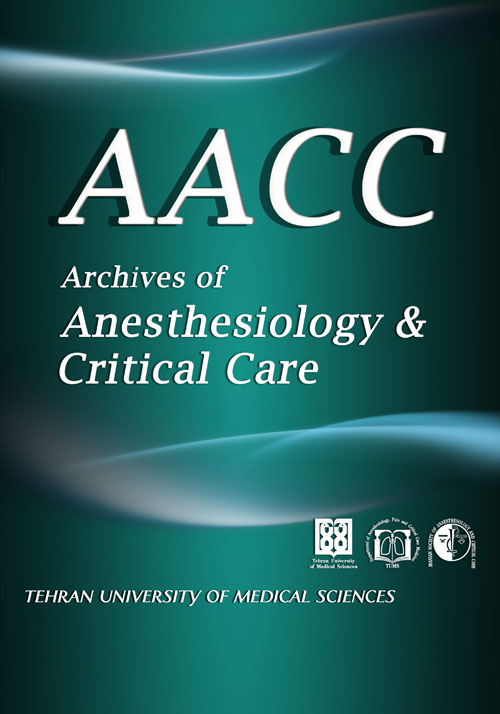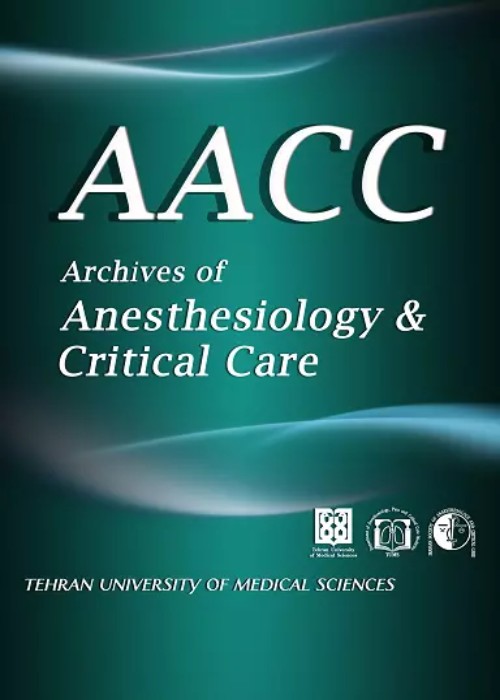فهرست مطالب

Archives of Anesthesiology and Critical Care
Volume:1 Issue: 4, autumn 2015
- تاریخ انتشار: 1394/09/15
- تعداد عناوین: 10
-
-
Pages 107-111BackgroundProlonged QT interval may lead to serious arrhythmias and ventricular fibrillation, hence prevention of the QT-interval prolongation is crucial for physicians. The aim of this study was to assess the influence of intravenous lidocaine on the QTc interval resulting from spinal anesthesia with bupivacaine.MethodsIn a randomized double blind trial, fifty male patients with mean age of 70.38 and ASA physical status ΙΙ, who underwent spinal anesthesia for elective orthopedic lower limb surgical procedures, were assessed. Our subjects were divided into two groups, patients randomly received intravenously either 1.5 mg/kg lidocaine 2% as test group (n=25), or 0.05 ml/kg isotonic sodium chloride as control group (n=25), just before inducing of spinal anesthesia. Spinal anesthesia was performed in the sitting position with 3 ml of 0.5% hyperbaric bupivacaine. Values of the QTc interval, heart rate, and arterial blood pressure were measured before spinal anesthesia as well as 1, 5, 15, and 30 minutes after spinal anesthesia.ResultsWith respect to the within-group values, statistically significant prolongation of the QTc interval as well as hemodynamic variability were detected in the measured times after blockade. There was no statistical difference between two groups according to hemodynamic parameters and the duration of the QTc interval before spinal anesthesia and times after spinal block with bupivacaine.ConclusionAdministration of intravenous lidocaine may not prevent the prolongation of the QTc interval and hemodynamic changes resulting from spinal anesthesia with hyperbaric bupivacaine, in elderly subjects.Keywords: spinal anesthesia, QT interval, bupivacaine
-
Pages 112-115BackgroundDeliberate hypotension is a strategy that reduces intraoperative bleeding and increases the speed of surgery in otolaryngology procedures. Magnesium (Mg) sulfate is a vasodilator agent that reduces intraoperative hypnotic requirements and in combination with analgesic agents, it reduces intraoperative and postoperative pain. In this study we evaluated the use of intravenous Mg sulfate for inducing deliberate hypotension in rhinoplasty.MethodsSixty ASA I, II patients aged between 18 to 45, scheduled for rhinoplasty were recruited into a randomized clinical trial. Patients were randomly assigned into placebo (group P) and Mg sulfate (group M) groups. For patients in group M, 40m/kg Mg sulfate was administered before induction and continued with 15mg/kg/hr infusion during the operation. Patients of group P received normal saline as placebo. In each group mean arterial pressure (MAP), mean heart rate, amount of bleeding, anesthetic agents, opioid requirement and duration of surgery were recorded. The incidence of nausea, vomiting, shivering and the score of pain were recorded in post-operative period in both groups.ResultsPatients in group M had lower MAP (P= 0.0001), less intraoperative bleeding (P=0.0001), lower anesthetic agents (P=0.0001) and opioid consumption (P=0.001), and shorter duration of procedure (P=0.0001). Mean heart rate was lower in group P (P=0.001). Moreover, surgeon`s satisfaction was more in group P (P=0.001).They also had less incidence of post-operative nausea and vomiting (P=0.008), shivering (P=0.001) and lower pain scores postoperatively (P=0.0001).ConclusionMagnesium sulfate can be a useful drug to induce controlled hypotension in rhinoplasty surgery. By employing this agent patients have better anesthetic condition and recovery profileKeywords: magnesium sulfate, controlled hypotension, rhinoplasty
-
Pages 116-119BackgroundVentilator-associated pneumonia (VAP) increases the cost of intensive care unit (ICU) treatment and the chance of mortality. Due to the increasing use of proton pump inhibitors (PPI) and H2 receptor inhibitors for stress ulcer prophylaxis, the purpose of the study was to investigate the differences of VAP in two groups of patients receiving PPI or H2 blocker.MethodsIn the retrospective cross sectional study, from September 2011 to September 2012, 43 patients who had positive pulmonary cultures (PC) were studied. These patients had a clinical pulmonary infection score (CPIS) ≥6 for more than 48 hours after receiving stress related mucosal diseases prophylaxis (SRMD). Patients whose SRMD prophylaxis was changed within 72 hours before obtaining the PC samples were excluded. Patients were divided into two groups. One group received pantoprazole (20 cases) and the other group received ranitidine (23 cases). Between the groups, age, sex, APACHE II score, predicted mortality, type of used SRMD prophylaxis drug, duration of prophylaxis prior to PC sampling, interval time between ICU admission and VAP manifestation, the type of bacterial causes of VAP, gastrointestinal bleeding, ICU length of stay and actual mortality were compared.ResultsThe APACHE II score and predicted mortality were higher in the pantoprazole group (P=0.173, 0.167). We found that 30% of the ranitidine group suffered from upper GI bleeding. In the pantoprazole group, 21.74% suffered from upper GI bleeding (P<0.001). Patients receiving ranitidine had a higher mortality rate and a worse prognosis (P< 0.001).ConclusionAlthough there were more critically ill patients with a higher predicted mortality in the pantoprazole group, the ranitidine recipients turned out to have a higher mortality rate.Keywords: Ventilator, associated pneumonia, stress related mucosal diseases, prophylaxis, intensive care unit
-
Pages 120-125BackgroundWe performed this study to evaluate the efficacy of melatonin, clonidine and gabapentin in reducing preoperative anxiety and postoperative pain in patients undergoing laparoscopic cholecystectomy.MethodsThis study was a randomized clinical trial on patients scheduled for laparoscopic cholecystectomy. A total number of 88 patients were categorized into four groups to receive melatonin, clonidine, gabapentin and placebo (22 patients per group). The anxiety level was evaluated by State-Train Anxiety Inventory (STAI) just before the entrance of patients into the operating room. The intensity of pain was determined according to standard VAS (Visual Analog Scale) criteria for pain assessment at 1, 2, 6, 12 and 24 hours after surgery. The times of receiving the first dose of morphine and also total amount of administered morphine during first 24 hours after surgery were documented. The frequency of vomiting episodes and the intensity of post-operative nausea and vomiting (PONV) during first 24 hours after surgery were recorded according to the VAS criteria.ResultsRegarding age, gender, weight, height, systolic blood pressure, diastolic blood pressure and heart rate, no significant differences were noted between the treatment groups. Also regarding the state-trait anxiety score, there were no significant differences between treatment groups (P=0.27). The pain intensity was different between groups (p<0.01); as the placebo group had the highest score; however paired comparison between intervention groups did not show significant differences. The intensity of pain was significantly decreased by the time (P<0.01) and depending on the assigned group, the pain reduction trend was different among treatment groups (P<0.01). In general, the clonidine group had the least pain score in different time periods.ConclusionUse of melatonin as a premedication had the efficacy similar to the efficacy of clonidine and gabapentin in reducing preoperative anxiety, postoperative pain and also reducing narcotic consumption.Keywords: Melatonin, gabapentin, preoperative anxiety, cholecystectomy, postoperative pain
-
Pages 126-129BackgroundClinical trials in surgical procedures have shown that dexamethasone reduced pain, nausea and vomiting postoperatively. The aim of this study was to compare the effect of dexamethasone on nausea and vomiting and labor pain in women who were candidates for normal vaginal delivery.MethodsIn a clinical trial, 60 pregnant women during labor were allocated to two groups receiving 8 mg dexamethasone intravenously (IV) slowly plus 50 mg pethidine intramuscularly (IM) (Group D), and 25 mg promethazine IV slowly plus 50 mg pethidine IM (Group P). The nausea and vomiting during labor and labor pain in our patients were recorded.ResultsGroup D had significantly lower nausea and vomiting during labor rather than group P (P = 0.03 and 0.008; respectively). The level of satisfaction and pain relief was not statistically different between two groups.ConclusionIt seems that dexamethasone is better than promethazine added to pethedine during labor in selected parturients.Keywords: dexamethasone, nausea, vomiting, labor pain
-
Pages 130-133BackgroundStatins (3-Hydroxy-3-methylglutarylcoenzyme-A (HMG-CoA) reductase inhibitors) decrease cardiovascular mortality and morbidity. This article reviews the role of perioperative statins in non cardiac surgery.MethodsA literature review was done on all English published articles till February 2015 about this subject using pubmed. Then the reference list of relevant articles was reviewed for additional resources.ResultsCurrent evidence shows that not only statins decrease perioperative morbidity and mortality in patients undergoing non cardiac surgery, but also they seem safe during perioperative period.ConclusionA properly designed randomized control trial should be performed to assess the perioperative benefits of statins in non cardiac surgery.Keywords: statins, non cardiac surgery, perioperative periods
-
Pages 134-138A 21-year old man with cervical spinal cord damage due to diving was admitted in the ICU. Tracheostomy was performed due to prolonged mechanical ventilation. Left lung atelectasis happened frequently. Because of the difficulty of bronchoscopy and failing of recruitment, using a double lumen, two tracheal tubes were guided into the left and right lungs through the tracheostomy stoma site. After 24 hours, the left lung was opened and ventilation was continued with a tracheostomy tube.Keywords: spinal cord injury, ventilator dependency, weaning, recruitmen
-
Pages 139-140Cutis laxa is rare and hetrogenous group of disorders related to abnormalities in elastic tissue. It may be autosomal recessive, autosomal dominant, X linked or acquired. Acquired cutis laxa has developed after a febrile illness, inflammatory skin disease such a lupus eryhymatosis or erythema multiform, amyloidosis, hypersensitivity reaction to penicillin and in infants born from women who were taking penicillamine. Patients with cutis laxa have facial features,.pulmonary emphysema, cor-pulmonale, and right-sided heart failure.We present a case with cutis laxa undescended testis, and mild pulmonary stenosis.Keywords: Cutis laxa, pulmonary stenosis, loose skin


